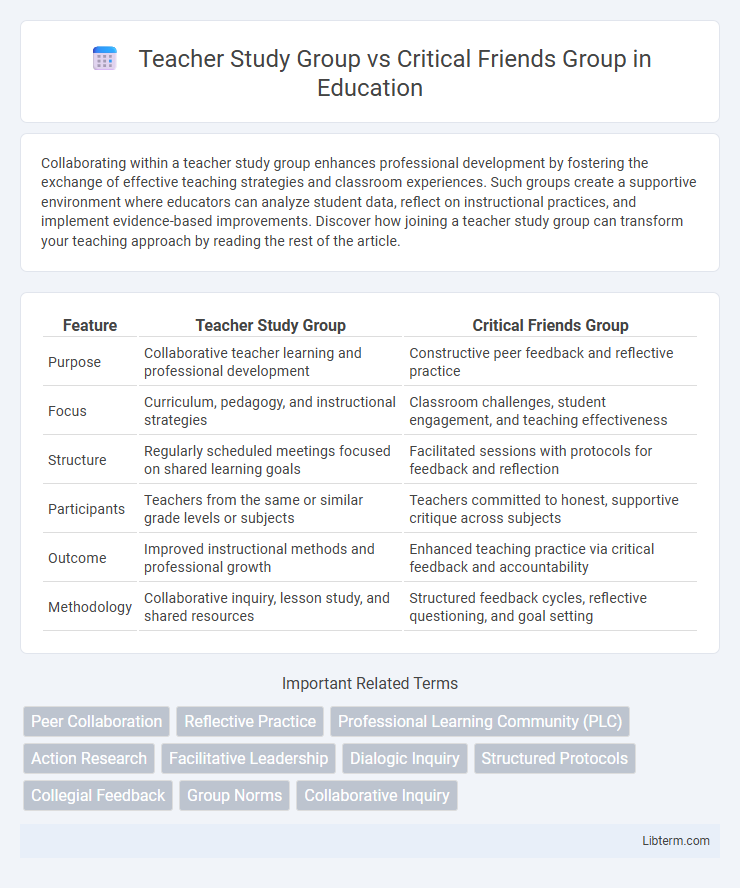Collaborating within a teacher study group enhances professional development by fostering the exchange of effective teaching strategies and classroom experiences. Such groups create a supportive environment where educators can analyze student data, reflect on instructional practices, and implement evidence-based improvements. Discover how joining a teacher study group can transform your teaching approach by reading the rest of the article.
Table of Comparison
| Feature | Teacher Study Group | Critical Friends Group |
|---|---|---|
| Purpose | Collaborative teacher learning and professional development | Constructive peer feedback and reflective practice |
| Focus | Curriculum, pedagogy, and instructional strategies | Classroom challenges, student engagement, and teaching effectiveness |
| Structure | Regularly scheduled meetings focused on shared learning goals | Facilitated sessions with protocols for feedback and reflection |
| Participants | Teachers from the same or similar grade levels or subjects | Teachers committed to honest, supportive critique across subjects |
| Outcome | Improved instructional methods and professional growth | Enhanced teaching practice via critical feedback and accountability |
| Methodology | Collaborative inquiry, lesson study, and shared resources | Structured feedback cycles, reflective questioning, and goal setting |
Introduction to Teacher Study Groups
Teacher Study Groups (TSGs) are collaborative professional learning communities where educators engage in focused inquiry, share classroom experiences, and analyze teaching practices to improve student outcomes. Unlike Critical Friends Groups, which emphasize constructive feedback through structured protocols, TSGs prioritize dialogic reflection and collective problem-solving rooted in real-time classroom challenges. These groups foster sustained teacher development by encouraging ongoing dialogue, data-driven discussions, and mutual support among peers.
Overview of Critical Friends Groups
Critical Friends Groups (CFGs) are collaborative educator teams focused on honest, supportive dialogue to improve teaching practices and student learning outcomes. CFGs emphasize structured feedback, reflective conversation, and collective problem-solving guided by established protocols, distinct from Teacher Study Groups which often prioritize self-directed inquiry and research. This model fosters a culture of trust and professional growth through ongoing peer coaching and accountability.
Purpose and Objectives of Each Group
Teacher Study Groups aim to enhance instructional practices by collaboratively analyzing student data and exploring effective teaching strategies, fostering professional growth through shared inquiry. Critical Friends Groups focus on providing constructive, candid feedback among educators to challenge assumptions and improve teaching quality, promoting reflective dialogue and trust-building. Both groups prioritize teacher development but differ in emphasis: Teacher Study Groups concentrate on collective analysis and learning, while Critical Friends Groups center on reflective critique and support.
Structure and Meeting Formats
Teacher Study Groups typically feature a collaborative structure where educators collectively analyze student work and teaching strategies through regular, agenda-driven meetings emphasizing inquiry and reflection. Critical Friends Groups are organized with assigned roles such as facilitator and recorder to guide structured protocols aimed at providing constructive feedback in a supportive environment. Both formats prioritize consistent meetings, but Teacher Study Groups lean toward exploratory dialogue while Critical Friends Groups focus on critical, solution-oriented discussions.
Key Roles and Responsibilities
Teacher Study Groups emphasize collaborative inquiry where educators analyze classroom data and refine instructional strategies, with roles including facilitator, note-taker, and participant responsible for reflective dialogue. Critical Friends Groups focus on providing constructive, evidence-based feedback to improve teaching practices, assigning roles such as facilitator, presenter, and critical friend to ensure honest, supportive critique. Both structures require committed participants who engage in trust-building, active listening, and shared accountability to foster professional growth and student achievement.
Facilitation Techniques and Protocols
Teacher Study Groups utilize structured facilitation techniques such as collaborative data analysis and reflective questioning to foster deep professional learning, emphasizing shared goals and inquiry cycles. Critical Friends Groups rely on formal protocols like the Critical Friends Protocol and consultancy protocol to create a safe, constructive environment where participants offer candid, focused feedback on teaching practices. Both groups prioritize equitable participation and trust-building through clearly defined facilitation roles and systematic dialogue procedures.
Collaboration and Peer Feedback
Teacher Study Groups foster collaboration through regular, structured meetings where educators share teaching strategies and analyze student work, promoting collective growth. Critical Friends Groups emphasize peer feedback by providing constructive critiques that challenge assumptions and elevate instructional practices. Both models prioritize reflective dialogue, but Critical Friends Groups often involve more rigorous, evidence-based feedback cycles to deepen professional learning.
Impact on Professional Development
Teacher Study Groups foster deep reflection and collaborative inquiry by encouraging educators to analyze student work and teaching practices, leading to tailored professional growth. Critical Friends Groups emphasize constructive feedback and peer coaching, enhancing interpersonal skills and promoting a culture of trust that supports continuous improvement. Both approaches significantly impact professional development by cultivating reflective practitioners committed to evidence-based teaching strategies.
Benefits and Challenges Compared
Teacher Study Groups enhance professional development through collaborative lesson planning and reflective dialogue, fostering deeper pedagogical understanding. Critical Friends Groups provide structured peer feedback cycles, promoting accountability and constructive critique, yet may pose challenges around trust-building and consistent participation. Both models improve instructional quality but require commitment to sustained collaboration and openness to diverse perspectives.
Choosing the Right Model for Your School
Selecting the appropriate collaborative professional development model depends on your school's goals, culture, and teacher needs. Teacher Study Groups prioritize deep content knowledge and curriculum improvement through structured inquiry, while Critical Friends Groups emphasize reflective dialogue and peer feedback to enhance teaching practices. Assessing factors like desired outcomes, time commitments, and faculty readiness helps ensure alignment with your school's unique environment and maximizes the impact on student learning.
Teacher Study Group Infographic

 libterm.com
libterm.com